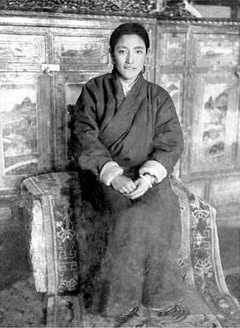Khandro's Plea
English | Deutsch | Français | བོད་ཡིག
Khandro's Plea[1]
by Jamyang Khyentse Chökyi Lodrö
ཀ་ཡེ་གསོན་དང་བླ་མ་རིན་པོ་ཆེ། །ཁ་ཞེ་མེད་པའི་དམ་ཆོས་མ་དྲན་ནས། །ག་ལེ་གུ་ལེས་མི་ཚེ་ཟད་འདུག་ལགས། །ང་ནི་ཤི་ནས་དམྱལ་བར་འགྲོ་ངེས་རེད། ཅེས་ཚེ་ཆོས་ནས་བྲིས།
Tsering Chödrön wrote:
"Ah, precious lama, listen please!
Bit by bit, as I fail to think sincerely about Dharma,
Continuously, steadily, this life of mine is slipping away.
Death, it is certain, will bring passage to the hells."[2]
ཁྱོ་པོ་བླ་མས་ལན་བཏབ་པ། དེ་ལ་ཕན་པ་ད་ལྟ་རང་ལག་ཡོད། །ཆོས་ཀྱི་རྣམ་གྲངས་མང་པོ་མ་ཐོན་རུང་། །ཀུན་ལ་ཕན་སེམས་བསམ་པ་བཟང་པོ་དང་། །དགེ་རྩ་བསྔོ་ཞིང་སྨོན་ལམ་བཟང་པོ་གདབ། །རང་སེམས་སྐྱེ་མེད་གསལ་སྟོང་ངོ་བོ་སྐྱོང་། །རྟག་ཏུ་བླ་མ་དྲན་ལ་གསོལ་བ་ཐོབ། །དེ་ནི་མདོ་རྒྱུད་ཀུན་གྱི་སྙིང་པོ་ཡིན། །ཅེས་གདམས་པའོ། །
Her husband, the lama, replied:
“Right now, you have all the help you need, in your own hands.
Even though you cannot manage many different kinds of Dharma practice,
Keep a good heart and be kind to everyone,
Dedicate the merit and make wholesome prayers of aspiration,
Maintain the unborn nature of the mind, which is the union of clarity and emptiness,
And always remember, and pray to, the guru.
That is the essence of all the sūtras and tantras.”
This was his advice.
| Rigpa Translations, 2011, and revised by Adam Pearcey with the generous support of the Khyentse Foundation and Tertön Sogyal Trust, 2022.
Bibliography
Tibetan Editions
'Jam dbyangs chos kyi blo gros. gsung thor bu/_'jam dbyangs chos kyi blo gros/ (rgya gar bir'i par ma/). (BDRC W21814). 2 vols. null: null, null. Vol. 2: 82
'Jam dbyangs chos kyi blo gros. gsung 'bum/_'jam dbyangs chos kyi blo gros/ (dbu med/). 8 vols. Gangtok: Dzongsar Khyentse Labrang, 1981–1985. (W21813). Vol. 2: 375–376
'Jam dbyangs chos kyi blo gros. "ka phreng gi dbyangs rtar drangs pa'i mgur/" in 'Jam dbyangs chos kyi blo gros kyi gsung 'bum. 12 vols. Bir, H.P.: Khyentse Labrang, 2012. (W1KG12986). Vol. 8: 334–335
Version: 2.2–202230714
-
The original is untitled; this title has been added by the translators. ↩
-
Khandro's question is in the form of an acrostic poem, the opening syllables of its four lines being the first four syllables of the Tibetan alphabet: ཀ་ (ka), ཁ་ (kha), ག་ (ga) and ང་ (nga). The translation aims to reproduce this effect, however unsatisfactorily, in abecedarian form. ↩
